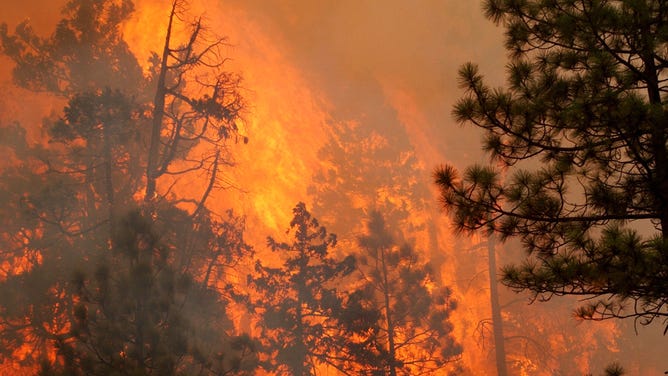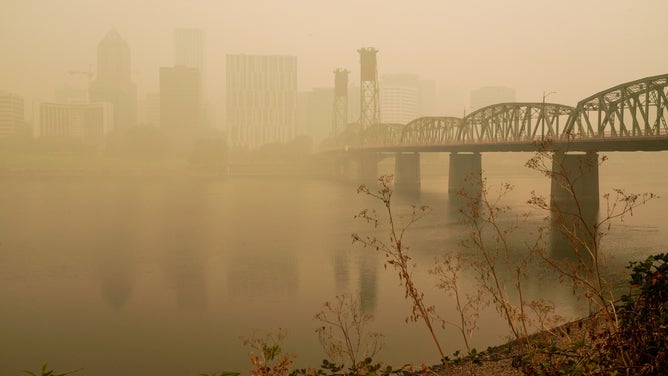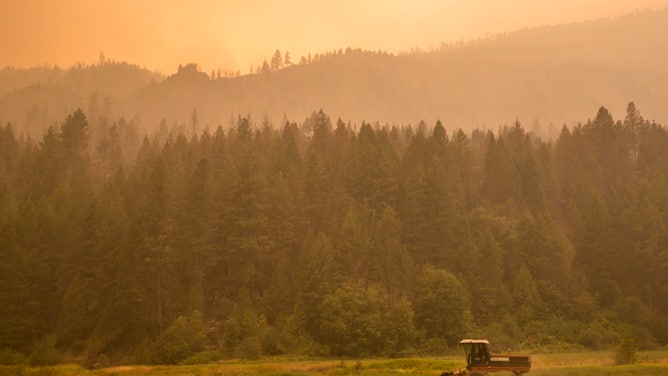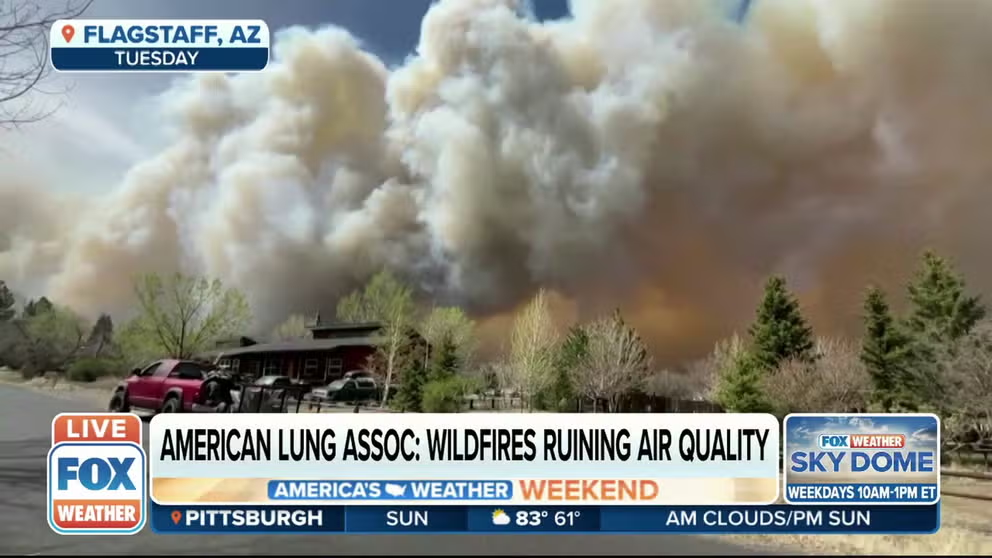Pacific Northwest wildfires change air pollution patterns, increase health risk across US, research finds
The research found that the pollutants from the wildfires could affect more than 130 million people from the Northwest to the Northeast U.S.

O'BRIEN, OR - AUGUST 4: Flames rip through the Siskiyou National Forest after Hot Shot fire crews lit a burnout fire August 4, 2002 in O'Brien, Oregon. Fire Crews continue to light burnout fires to try and stop a 188,000 acre fire in the Siskiyou National Forest.
((Photo by Justin Sullivan/Getty Images) / Getty Images)
Scientists at the National Center for Atmospheric Research (NCAR) found that wildfires in the Pacific Northwest are altering the air pollution patterns across the U.S. via an "atmospheric river of smoke" and posing potential risks to the health of millions.
NCAR scientist Rebecca Buchholz says that wildfire emissions have increased substantially, changing the annual pattern of air quality across the country and potentially leading to a significant increase in respiratory-related deaths.
Her research found that levels of carbon monoxide increased sharply in August during the peak of wildfire season in the Northwest. Spikes in carbon monoxide had always been found in earlier months, but the new data showing the increase in August was concerning.
She and her team track carbon monoxide as it is a gas that indicates the presence of other air pollutants, specifically aerosols and ground-level ozone that can cause health problems.
"One of the reasons we use carbon monoxide is because it’s emitted from fires," Buchholz said. "And it’s really good to use to track where the pollution plume from smoke from fires is going."
Previous research showed a downward trend in carbon monoxide up until the past few years.
"We looked at the trends between 2002 and 2018 and found that in August, there was an increase in carbon monoxide that was centering over the Pacific Northwest region," Buchholz said. "This was completely opposite to what we’ve been finding."

KERBY, OR - AUGUST 3: Firefighter Jose Martinez, from Ontario, Oregon, puts out a hot spot from a controlled burn to make a fire line in the Siskiyou National Forest August 3,2002 outside of Kerby, Oregon. The188,000 acre fire is 5 percent contained but continues to threaten nearly 17,000 residents of the Illinois Valley.
((Photo by Justin Sullivan/Getty Images) / Getty Images)
The timespan corresponded with the peak summer burning season of the Pacific Northwest. August is one of the driest months in the West, and NCAR says the trend was especially pronounced from 2012 to 2018, coinciding when the fire season became more active in the Pacific Northwest.
They found conclusive evidence of where the smoke was originating after using a mix of satellite-based observations of atmospheric chemistry, computer modeling, and global inventories of the fires to track the wildfires.
"Research had shown that the aerosol increase in that region is due to the Pacific Northwest fires," Buchholz said.
Buchholz said that her team eliminated other potential emission sources from other parts of the world.
"It wasn’t something being transported into North America. It’s happening in the Pacific Northwest, and we used a little bit of detective work to link the fires to that increase in carbon monoxide in August," she said.

The downtown skyline and Hawthorne Bridge as smoke from wildfires fills the air in Portland, Oregon, U.S., on Wednesday, Sept. 16, 2020.
(Rebecca Smeyne/Bloomberg via Getty Images / Getty Images)
Once her team conclusively linked the highest emissions rates were in the Pacific Northwest, the rest of the world didn’t even compare in the late summer months.
"Globally, that’s where the strongest carbon monoxide positive trend in August is happening," she said.
Wildfires have increased significantly across the U.S., and fires are a more significant factor in air pollution.
"Multiple lines of evidence point to the worsening wildfires in the Pacific Northwest as the cause of degraded air quality," Buchholz said.
And just like the wintertime atmospheric rivers carry storms and heavy rains farther inland, the continual westerly flow off the Pacific Ocean only means worse conditions for those downwind.
"It’s like an atmospheric river of smoke," she explained. "And so, you get the transport of aerosols, and you also get the transport of the carbon monoxide. And along with all of those, the carbon monoxide is kind of a tracer of all the other trace gases and pollutants that are emitted from fires that will be transported along in that smoke plume."
Doctors agree that the smoke can impact those who aren’t even near fires.
Wildfires taking toll on air quality
Paul Walsh from BreezoMeter joins FOX Weather to talk about the wildfires and how it's impacting our health.
"The worry for human health or the impact on human health really comes from these aerosols. The smoke particles, the fine particles that can get trapped in human lungs, can cause irritation and inflammation and cardiovascular problems," Buchholz explains. "The other thing that happens in smoke is ground-level ozone can be created, and that’s also an inflammatory atmospheric pollutant."
So, she and her team started looking at the effects on human health in the Pacific Northwest and other parts of the country.
"I would expect that in these other regions that we’re seeing increases in fires as well, that their carbon monoxide would be increasing due to fires as well," she said.
After running simulations on their computer models, they found that the pollutants could affect more than 130 million people, including about 34 million in the Pacific Northwest, 23 million in the Central U.S., and 72 million in the Northeast.
NCAR says the team looked at respiratory death rates in Colorado for August from 2002 to 2011, compared with the same month in 2012 to 2018. They found that respiratory deaths in August increased significantly during the 2012-2018 period when fires in the Pacific Northwest — but not in Colorado — produced more emissions in August.

OMAK, WA - AUGUST 23: A farmer mows alfalfa amid the smoke from the Okanagon Complex Wildfires on August 23, 2015 near Omak, Washington. More than 1,000 personnel are fighting the Okanagon Complex Fires which have burned more 239,000 acres.
((Photo by Stephen Brashear/Getty Images) / Getty Images)
Buchholz continues her work into more than just centering on the Pacific Northwest. She says she is working with a health expert at Colorado State University to do an in-depth study on the health impacts of smoke from fires.
"We’re trying to separate out the Pacific Northwest smoke plumes from the local [historical] fires that we’re seeing in Colorado and trying to understand how each of these things impacts health," she said.
She hopes that through her research with CSU and the University of Toronto, she can determine the effects of the long-distance transported smoke plumes and the furthering impact on human health.
